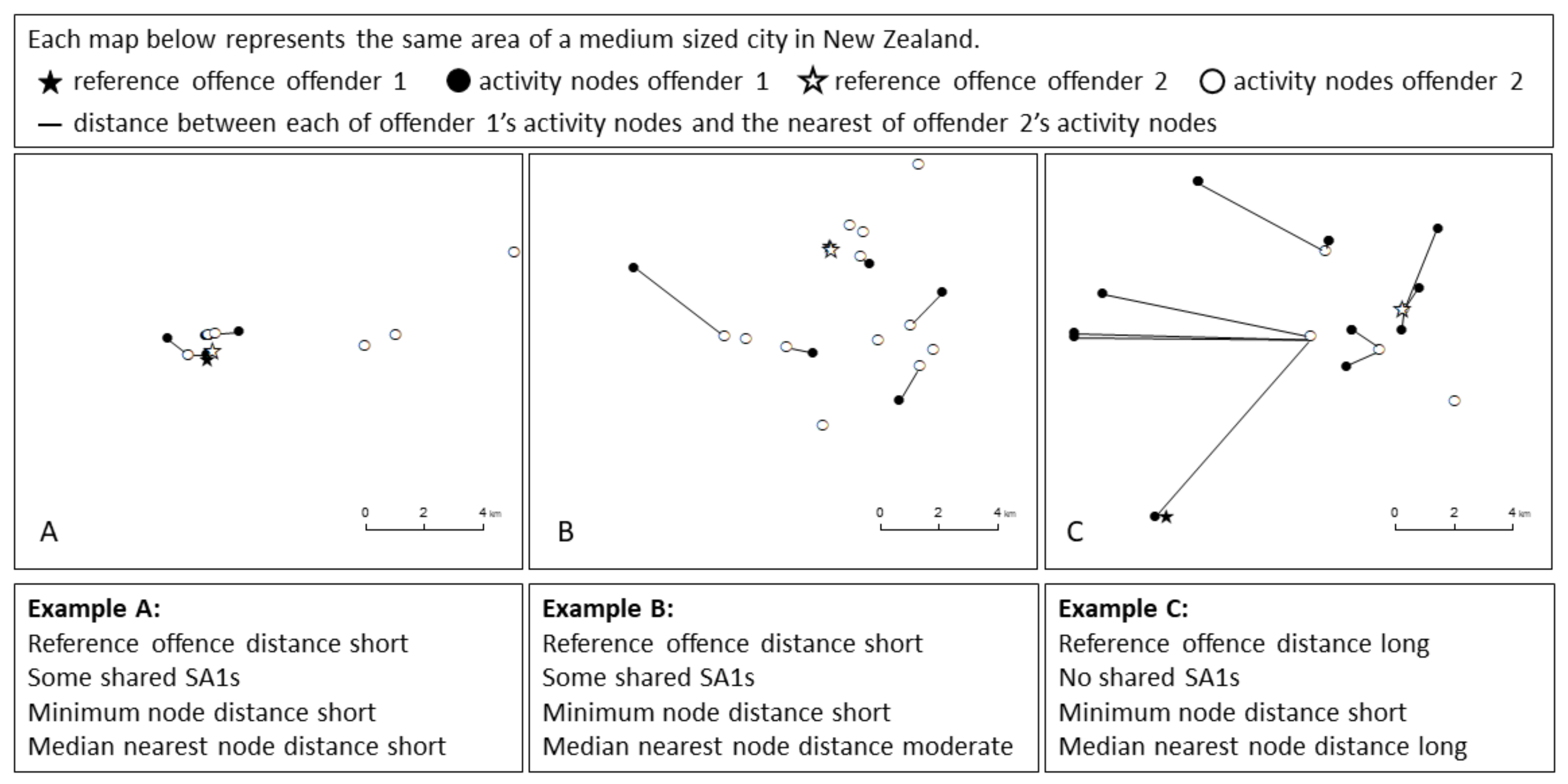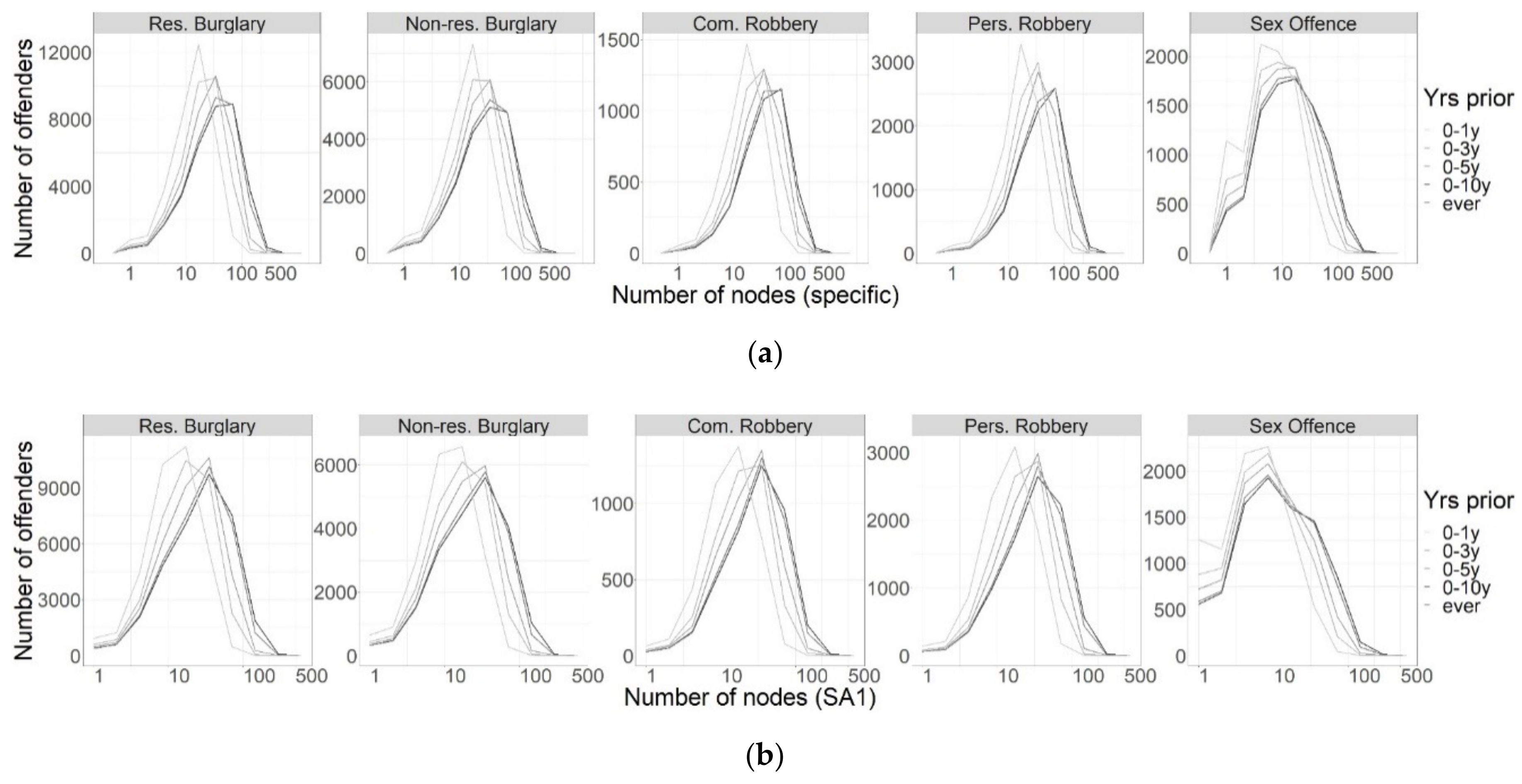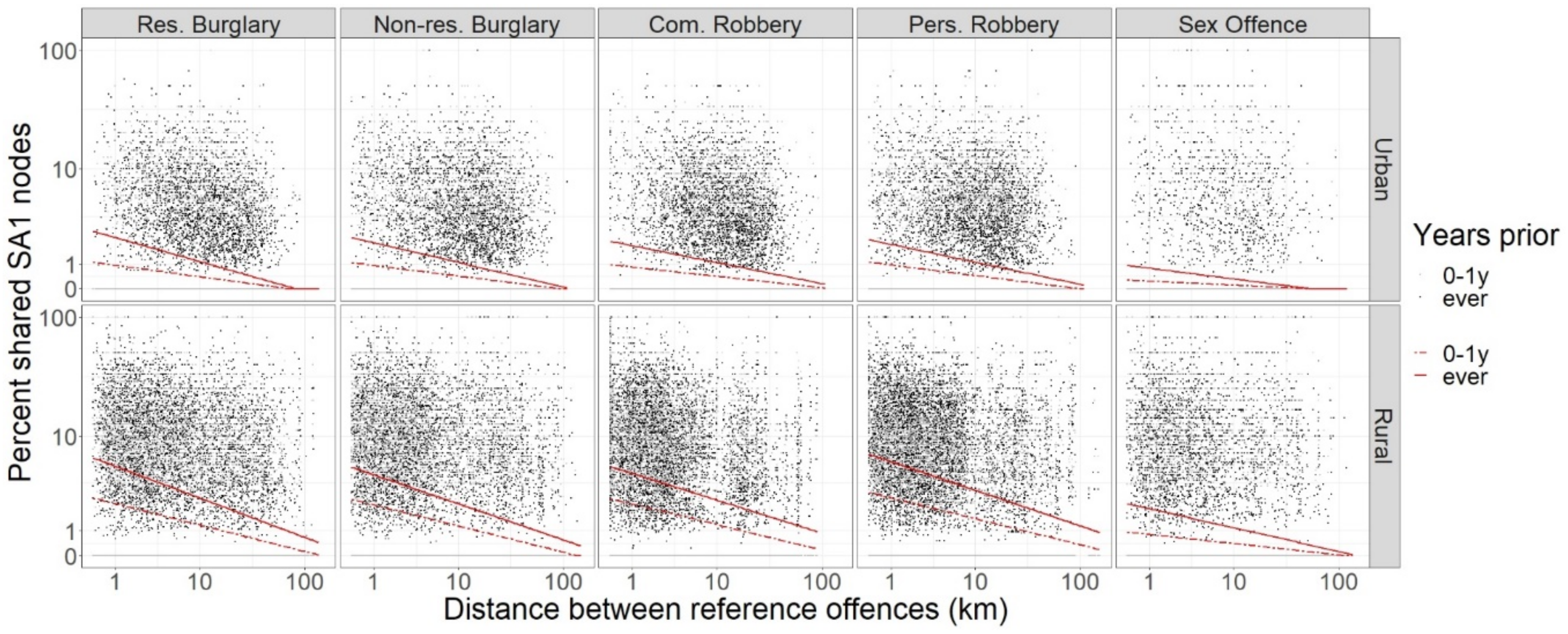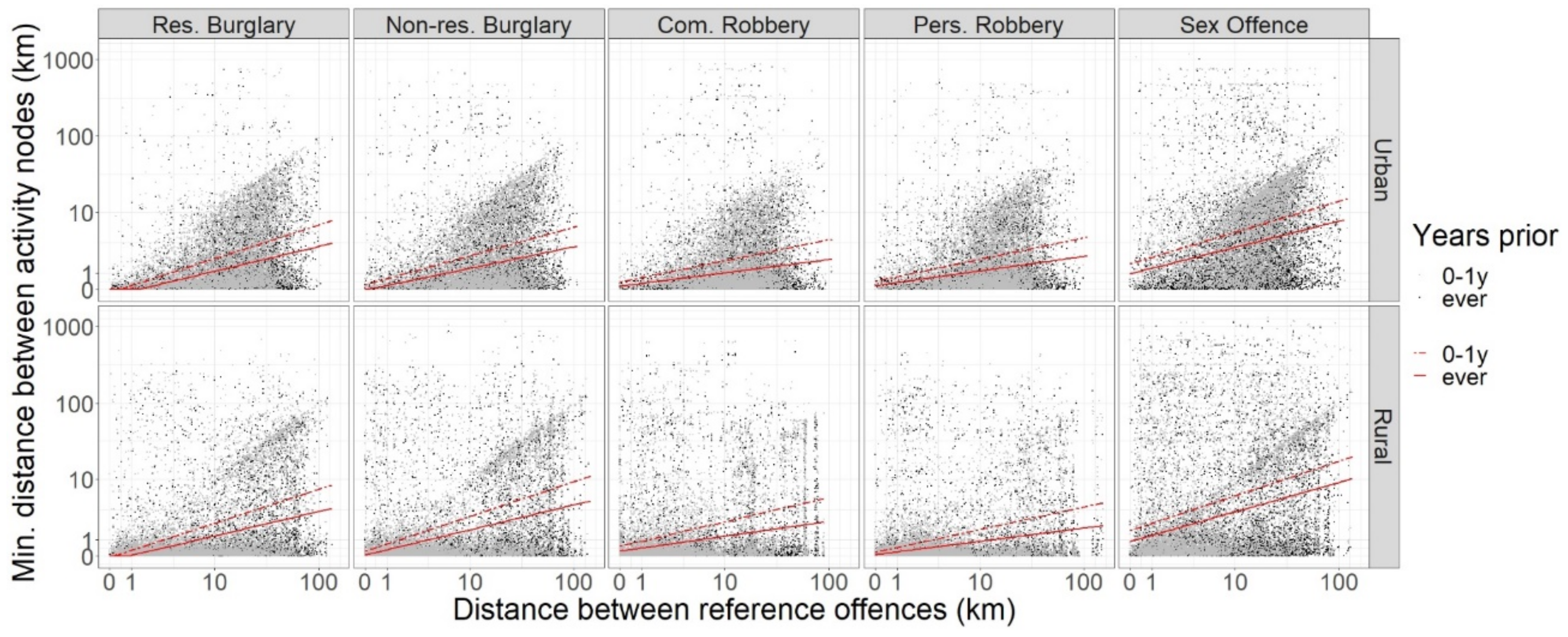A National Examination of the Spatial Extent and Similarity of Offenders’ Activity Spaces Using Police Data
Abstract
:1. Introduction
1.1. Offenders’ Activity Spaces
1.2. Homology and Differentiation in Activity Spaces
1.3. Present Study
2. Materials and Methods
2.1. Data
2.2. Analytic Approach
2.2.1. Number of Activity Nodes
2.2.2. Activity Space Size
2.2.3. Shared Activity Space
2.2.4. Homology and Differentiation
2.2.5. Analysis Dimensions
3. Results
3.1. Number of Activity Nodes
3.2. Activity Space Size
3.3. Shared Activity Space
3.4. Homology and Differentiation
4. Discussion
5. Conclusions
Supplementary Materials
Author Contributions
Funding
Institutional Review Board Statement
Informed Consent Statement
Data Availability Statement
Acknowledgments
Conflicts of Interest
References
- Brantingham, P.L.; Brantingham, P.J. Notes on the geometry of crime. In Environmental Criminology; Waveland Press: Prospect Heights, IL, USA, 1991; pp. 27–54. ISBN 978-0-8039-1678-4. [Google Scholar]
- Brantingham, P.L.; Brantingham, P.J. Environment, routine, and situation: Toward a pattern theory of crime. In Routine Activity and Rational Choice-Advances in Criminological Theory; Clarke, R.V., Felson, M., Eds.; Transaction Publishers: Piscataway, NJ, USA, 1993; pp. 259–294. ISBN 978-1-56000-087-7. [Google Scholar]
- Ruiter, S. Crime location choice. In The Oxford Handbook of Offender Decision Making; Bernasco, W., Van Gelder, J.-L., Elffers, H., Eds.; Oxford University Press: Oxford, UK, 2017; pp. 398–420. [Google Scholar]
- Curtis-Ham, S.; Bernasco, W.; Medvedev, O.N.; Polaschek, D. A Framework for Estimating Crime Location Choice Based on Awareness Space. Crime Sci. 2020, 9, 1–14. [Google Scholar] [CrossRef]
- Chesher, C. Digitising the Beat: Police Databases and Incorporeal Transformations. Convergence 1997, 3, 72–81. [Google Scholar] [CrossRef]
- Garicano, L.; Heaton, P. Information Technology, Organization, and Productivity in the Public Sector: Evidence from Police Departments. J. Labor Econ. 2010, 28, 167–201. [Google Scholar] [CrossRef] [Green Version]
- Home Office National Law Enforcement Data Programme. Law Enforcement Data Service (LEDS)–Privacy Impact Assessment Report; Home Office: London, UK, 2018.
- Schellenberg, K. Police Information Systems, Information Practices and Individual Privacy. Can. Public Policy 1997, 23, 23–39. [Google Scholar] [CrossRef]
- Long, D.; Liu, L.; Feng, J.; Zhou, S. Assessing the Influence of Prior on Subsequent Street Robbery Location Choices: A Case Study in ZG City, China. Sustainability 2018, 10, 1818. [Google Scholar] [CrossRef] [Green Version]
- Canter, D. Geographical profiling of criminals. In Principles of Geographical Offender Profiling; Canter, D., Youngs, D., Eds.; Ashgate: Aldershot, UK, 2008; pp. 259–270. ISBN 978-0-7546-2547-6. [Google Scholar]
- Rossmo, D.K. Geographic Profiling; CRC Press: Boca Raton, FL, USA, 2000; ISBN 0-8493-8129-0. [Google Scholar]
- Cohen, L.E.; Felson, M. Social Change and Crime Rate Trends: A Routine Activity Approach. Am. Sociol. Rev. 1979, 44, 588–608. [Google Scholar] [CrossRef]
- Weisburd, D.; Eck, J.E.; Braga, A.A.; Telep, C.W.; Cave, B.; Bowers, K.; Bruinsma, G.J.N.; Gill, C.; Groff, E.R.; Hibdon, J.; et al. Place Matters: Criminology for the Twenty-First Century; Cambridge University Press: Cambridge, UK, 2016. [Google Scholar]
- Weisburd, D. The Law of Crime Concentration and the Criminology of Place. Criminology 2015, 53, 133–157. [Google Scholar] [CrossRef]
- Townsley, M. Offender mobility. In Environmental Criminology and Crime Analysis; Wortley, R., Townsley, M., Eds.; Routledge: London, UK, 2016; pp. 142–161. ISBN 978-1-317-48710-4. [Google Scholar]
- Canter, D.; Hodge, S. Criminals’ mental maps. In Atlas of Crime: Mapping the Criminal Landscape; Turnbull, L., Hendrix, E., Dent, B., Eds.; Oryx Press: Phoenix, AZ, USA, 2000; pp. 186–191. [Google Scholar]
- Davies, A.; Dale, A. Locating the Stranger Rapist. Med. Sci. Law 1996, 36, 146–156. [Google Scholar] [CrossRef]
- Pettiway, L.E. Copping Crack: The Travel Behavior of Crack Users. Justice Q. 1995, 12, 499–524. [Google Scholar] [CrossRef]
- Rengert, G.; Wasilchick, J. Suburban Burglary: A Time and a Place for Everything; C.C. Thomas: Springfield, IL, USA, 1985; ISBN 978-0-398-05142-6. [Google Scholar]
- Summers, L.; Johnson, S.D.; Rengert, G. The use of maps in offender interviewing. In Offenders on Offending: Learning about Crime from Criminals; Bernasco, W., Ed.; Willan: Collumpton, Devon, UK, 2010; pp. 246–272. [Google Scholar]
- van Daele, S. Itinerant crime groups: Mobility attributed to anchor points? In Contemporary Issues in the Empirical Study of Crime; Governance of Security Research Paper Series; Pauwels, L., Ponsaers, P., Vande Walle, G., Vander Beken, T., Vander Laenen, F., Vermeulen, G., Cools, M., De Kimpe, S., De Ruyver, B., Easton, M., Eds.; Maklu: Antwerp, Belgium, 2009; Volume 1, pp. 211–225. [Google Scholar]
- Wiles, P.; Costello, A. The “road to nowhere”: The evidence for travelling criminals. In Principles of Geographical Offender Profiling; Canter, D., Youngs, D., Eds.; Ashgate: Aldershot, UK, 2008; pp. 165–175. [Google Scholar]
- Frith, M.J. Modelling Taste Heterogeneity Regarding Offence Location Choices. J. Choice Model. 2019, 33, 100187. [Google Scholar] [CrossRef]
- Menting, B. Awareness × Opportunity: Testing Interactions between Activity Nodes and Criminal Opportunity in Predicting Crime Location Choice. Br. J. Criminol. 2018, 58, 1171–1192. [Google Scholar] [CrossRef]
- Menting, B.; Lammers, M.; Ruiter, S.; Bernasco, W. Family Matters: Effects of Family Members’ Residential Areas on Crime Location Choice. Criminology 2016, 54, 413–433. [Google Scholar] [CrossRef]
- Van Sleeuwen, S.E.M.; Ruiter, S.; Menting, B. A Time for a Crime: Temporal Aspects of Repeat Offenders’ Crime Location Choices. J. Res. Crime Delinq. 2018, 55, 538–568. [Google Scholar] [CrossRef]
- Bernasco, W. Adolescent Offenders’ Current Whereabouts Predict Locations of Their Future Crimes. PLoS ONE 2019, 14, e0210733. [Google Scholar] [CrossRef]
- Menting, B.; Lammers, M.; Ruiter, S.; Bernasco, W. The Influence of Activity Space and Visiting Frequency on Crime Location Choice: Findings from an Online Self-Report Survey. Br. J. Criminol. 2020, 60, 303–322. [Google Scholar] [CrossRef]
- Rossmo, D.K.; Lu, Y.; Fang, T.B. Spatial-temporal crime paths. In Patterns, Prevention, and Geometry of Crime; Andresen, M.A., Kinney, J.B., Eds.; Routledge: London, UK, 2012; pp. 3–15. [Google Scholar]
- Rossmo, D.K.; Rombouts, S. Geographic profiling. In Environmental Criminology and Crime Analysis; Wortley, R., Mazerolle, L., Eds.; Willan: Collumpton, Devon, UK, 2008; pp. 136–149. [Google Scholar]
- Canter, D. Offender Profiling and Criminal Differentiation. Leg. Criminol. Psychol. 2000, 5, 23–46. [Google Scholar] [CrossRef] [Green Version]
- Doan, B.; Snook, B. A Failure to Find Empirical Support for the Homology Assumption in Criminal Profiling. J. Police Crim. Psychol. 2008, 23, 61–70. [Google Scholar] [CrossRef]
- Woodhams, J.; Toye, K. An Empirical Test of the Assumptions of Case Linkage and Offender Profiling with Serial Business Robberies. Psychol. Public Policy Law 2007, 13, 59–85. [Google Scholar] [CrossRef]
- Costanzo, C.; Halperin, W.; Gale, N. Criminal mobility and the directional component in journeys to crime. In Metropolitan Crime Patterns; Figlio, R., Hakim, S., Rengert, G., Eds.; Criminal Justice Press: Monsey, NY, USA, 1986; pp. 73–96. [Google Scholar]
- Lammers, M. Co-Offenders’ Crime Location Choice: Do Co-Offending Groups Commit Crimes in Their Shared Awareness Space? Br. J. Criminol. 2018, 58, 1193–1211. [Google Scholar] [CrossRef]
- Tayebi, M.A.; Frank, R.; Glässer, U. Understanding the Link between Social and Spatial Distance in the Crime World. In Proceedings of the 20th International Conference on Intelligent User Interfaces, Redondo Beach, CA, USA, 6 November 2012. [Google Scholar]
- Malm, A.; Kinney, J.B.; Pollard, N. Social Network and Distance Correlates of Criminal Associates Involved in Illicit Drug Production. Secur. J. 2008, 21, 77–94. [Google Scholar] [CrossRef]
- Bernasco, W. Them Again?: Same-Offender Involvement in Repeat and near Repeat Burglaries. Eur. J. Criminol. 2008, 5, 411–431. [Google Scholar] [CrossRef] [Green Version]
- Haginoya, S.; Hanayama, A.; Koike, T. Linkage Analysis Using Geographical Proximity: A Test of the Efficacy of Distance Measures. J. Criminol. Res. Policy Pr. 2020. [Google Scholar] [CrossRef]
- Johnson, S.D.; Summers, L.; Pease, K. Offender as Forager? A Direct Test of the Boost Account of Victimization. J. Quant. Criminol. 2009, 25, 181–200. [Google Scholar] [CrossRef]
- Tonkin, M.; Woodhams, J.; Bull, R.; Bond, J.W.; Palmer, E.J. Linking Different Types of Crime Using Geographical and Temporal Proximity. Crim. Justice Behav. 2011, 38, 1069–1088. [Google Scholar] [CrossRef]
- Tonkin, M.; Santtila, P.; Bull, R. The Linking of Burglary Crimes Using Offender Behaviour: Testing Research Cross-Nationally and Exploring Methodology. Leg. Criminol. Psychol. 2012, 17, 276–293. [Google Scholar] [CrossRef] [Green Version]
- De Montjoye, Y.-A.; Hidalgo, C.; Verleysen, M.; Blondel, V. Unique in the Crowd: The Privacy Bounds of Human Mobility. Sci. Rep. 2013, 3, 1376. [Google Scholar] [CrossRef] [Green Version]
- Yeoman, A.; Cook, L.W. The Kiwi Nest: 60 Years of Change in New Zealand Families; Families Commission: Wellington, New Zealand, 2008.
- R Core Team. R: A Language and Environment for Statistical Computing.; R Foundation for Statistical Computing: Vienna, Austria, 2013. [Google Scholar]
- Andresen, M.A.; Malleson, N.; Steenbeek, W.; Townsley, M.; Vandeviver, C. Minimum Geocoding Match Rates: An International Study of the Impact of Data and Areal Unit Sizes. Int. J. Geogr. Inf. Sci. 2020, 34, 1306–1322. [Google Scholar] [CrossRef]
- Briz-Redón, Á.; Martinez-Ruiz, F.; Montes, F. Re-Estimating a Minimum Acceptable Geocoding Hit Rate for Conducting a Spatial Analysis. Int. J. Geogr. Inf. Sci. 2019, 34, 1283–1305. [Google Scholar] [CrossRef]
- Bernasco, W. Modeling Micro-Level Crime Location Choice: Application of the Discrete Choice Framework to Crime at Places. J. Quant. Criminol. 2010, 26, 113–138. [Google Scholar] [CrossRef]
- Hanson, S.; Huff, O.J. Systematic Variability in Repetitious Travel. Transportation 1988, 15, 111–135. [Google Scholar] [CrossRef]
- Pappalardo, L. The Origin of Heterogeneity in Human Mobility Ranges. In Proceedings of the CEUR Workshop Proceedings CEUR-WS, Bordeaux, France, 15 March 2016. [Google Scholar]
- Pappalardo, L.; Simini, F.; Rinzivillo, S.; Pedreschi, D.; Giannotti, F.; Barabási, A.-L. Returners and Explorers Dichotomy in Human Mobility. Nat. Commun. 2015, 6, 8166–8173. [Google Scholar] [CrossRef] [PubMed] [Green Version]
- Schönfelder, S.; Axhausen, K.W. Measuring the Size and Structure of Human Activity Spaces: The Longitudinal Perspective; ETH: Zurich, Switzerland, 2002. [Google Scholar]
- Pebesma, E. Simple Features for R: Standardized Support for Spatial Vector Data. R J. 2018, 10, 439. [Google Scholar] [CrossRef] [Green Version]
- Patterson, Z.; Farber, S. Potential Path Areas and Activity Spaces in Application: A Review. Transp. Rev. 2015, 35, 679–700. [Google Scholar] [CrossRef]
- Mokros, A.; Alison, L.J. Is Offender Profiling Possible? Testing the Predicted Homology of Crime Scene Actions and Background Characteristics in a Sample of Rapists. Leg. Criminol. Psychol. 2002, 7, 25–43. [Google Scholar] [CrossRef]
- Alessandretti, L.; Sapiezynski, P.; Sekara, V.; Lehmann, S.; Baronchelli, A. Evidence for a Conserved Quantity in Human Mobility. Nat. Hum. Behav. 2018, 2, 485–491. [Google Scholar] [CrossRef]
- Canter, D.; Shalev, K. Putting crime in its place: A psychological process in crime site selection. In Principles of Geographical Offender Profiling; Canter, D., Youngs, D., Eds.; Ashgate: Aldershot, UK, 2008; pp. 259–270. ISBN 978-0-7546-2547-6. [Google Scholar]
- Marchment, Z.; Bouhana, N.; Gill, P. Lone Actor Terrorists: A Residence-to-Crime Approach. Terror. Political Violence 2018, 1–26. [Google Scholar] [CrossRef]
- González, M.C.; Hidalgo, C.A.; Barabási, A.-L. Understanding Individual Human Mobility Patterns. Nature 2008, 453, 779–782. [Google Scholar] [CrossRef]
- Hart, T.C.; Birks, D.; Townsley, M.; Ruiter, S.; Bernasco, W. Activity nodes, activity spaces, and awareness spaces: Measuring geometry of crime’s constructs with smartphone data. In Space, Time, and Crime; Hart, T.C., Lersch, K.M., Chataway, M., Eds.; Carolina Academic Press: Durham, NC, USA, 2020; pp. 156–176. ISBN 978-1-5310-1540-4. [Google Scholar]
- Hammond, L. Geographical Profiling in a Novel Context: Prioritising the Search for New Zealand Sex Offenders. Psychol. Crime Law 2014, 20, 358–371. [Google Scholar] [CrossRef] [Green Version]
- Lundrigan, S.; Czarnomski, S.; Wilson, M. Spatial and Environmental Consistency in Serial Sexual Assault. J. Investig. Psych. Offender Profil. 2010, 7, 15–30. [Google Scholar] [CrossRef] [Green Version]
- Lundrigan, S.; Czarnomski, S. Spatial Characteristics of Serial Sexual Assault in New Zealand. Aust. N. Z. J. Criminol. 2006, 39, 218–231. [Google Scholar] [CrossRef]
- Scott, D. The Travelling Distances of Stranger Intruder Sex Offenders; New Zealand Police: Wellington, New Zealand, 2012.
- Davidson, R.N. Patterns of Residential Burglary in Christchurch. N. Z. Geogr. 1980, 36, 73–78. [Google Scholar] [CrossRef]
- Superu. Residential Movement within New Zealand: Quantifying and Characterising the Transient Population; Social Policy Evaluation and Research Unit: Wellington, New Zealand, 2018.
- Ministry of Transport. 25 Years of New Zealand Travel: New Zealand Household Travel 1989–2014; Ministry of Transport: Wellington, New Zealand, 2015.
- Ministry of Transport. New Zealand Household Travel Survey 2015–2017; Ministry of Transport: Wellington, New Zealand, 2017.
- Ministry of Transport. Transport Outlook Current State 2016: A Summary of New Zealand’s Transport System; Ministry of Transport: Wellington, New Zealand, 2017.
- Ministry of Transport. Inter-Regional Ground Travel by Residents. Available online: https://www.transport.govt.nz/mot-resources/research-papers/inter-regional-ground-travel-data-from-qrious/ (accessed on 1 April 2020).
- Vuletich, S.; Becken, S. The Tourism Flows Model: Summary Document; Ministry of Tourism: Wellington, New Zealand, 2007.
- Witten, K.; Huakau, J.; Mavoa, S. Social and Recreational Travel: The Destinations, Travel Modes and CO2 Emissions of New Zealand Households. Soc. Policy J. N. Z. 2011, 37, 172–184. [Google Scholar]
- Robson, S.; Yesberg, J.A.; Wilson, M.S.; Polaschek, D.L.L. A Fresh Start or the Devil You Know? Examining Relationships between Release Location Choices, Community Experiences, and Recidivism for High-Risk Parolees. Int. J. Offender Ther. Comp. Criminol. 2019, 64, 35–653. [Google Scholar] [CrossRef] [PubMed]
- Goldsmith, A.; Halsey, M. Cousins in Crime: Mobility, Place and Belonging in Indigenous Youth Co-Offending. Br. J. Criminol. 2013, 53, 1157–1177. [Google Scholar] [CrossRef]
- Reiss, A.J., Jr.; Farrington, D.P. Advancing Knowledge about Co-Offending: Results from a Prospective Longitudinal Survey of London Males. J. Crim. Law Criminol. 1991, 82, 360–395. [Google Scholar] [CrossRef] [Green Version]
- Mcgloin, J.M.; Povitsky Stickle, W. Influence or Convenience? Disentangling Peer Influence and Co-Offending for Chronic Offenders. J. Res. Crime Delinq. 2011, 48, 419–447. [Google Scholar] [CrossRef] [Green Version]
- Weerman, F. Co-Offending as Social Exchange: Explaining Characteristics of Co-Offending. Br. J. Criminol. 2003, 43, 398–416. [Google Scholar] [CrossRef]
- Liu, Z.; Qiao, Y.; Tao, S.; Lin, W.; Yang, J. Analyzing Human Mobility and Social Relationships from Cellular Network Data. In Proceedings of the 13th International Conference on Network and Service Management (CNSM), Tokyo, Japan, 26–30 November 2017; pp. 1–6. [Google Scholar]
- Toole, J.L.; Herrera-Yaqüe, C.; Schneider, C.M.; González, M.C. Coupling Human Mobility and Social Ties. J. R. Soc. Interface 2015, 12, 20141128. [Google Scholar] [CrossRef] [Green Version]
- Wang, D.; Pedreschi, D.; Song, C.; Giannotti, F.; Barabasi, A.-L. Human Mobility, Social Ties, and Link Prediction. In Proceedings of the 17th ACM SIGKDD International Conference on Knowledge Discovery and Data Mining, San Diego, CA, USA, 21–24 August 2011; pp. 1100–1108. [Google Scholar]
- Xu, Y.; Belyi, A.; Bojic, I.; Ratti, C. How Friends Share Urban Space: An Exploratory Spatiotemporal Analysis Using Mobile Phone Data. Trans. GIS 2017, 21, 468–487. [Google Scholar] [CrossRef]
- Felson, M. The process of co-offending. In Theory and Practice in Situational Crime Prevention; Smith, M.J., Cornish, D.B., Eds.; Criminal Justice Press: Monsey, NY, USA, 2003; pp. 149–167. [Google Scholar]
- Schaefer, D.R. Youth Co-Offending Networks: An Investigation of Social and Spatial Effects. Soc. Netw. 2012, 34, 141–149. [Google Scholar] [CrossRef]
- Centre for Social Research and Evaluation. From Wannabes to Youth Offenders: Youth Gangs in Counties Manukau; Ministry of Social Development: Wellington, New Zealand, 2008.
- Eggleston, E.J. New Zealand Youth Gangs: Key Findings and Recommendations from an Urban Ethnography. Soc. Policy J. N. Z. 2000, 14. [Google Scholar]
- Gilbert, J. Patched: The History of Gangs in New Zealand; Auckland University Press: Auckland, New Zealand, 2013; ISBN 978-1-86940-729-2. [Google Scholar]
- New Zealand Parliament. Youth Gangs in New Zealand; New Zealand Parliamentary Service: Wellington, New Zealand, 2019.
- Office of the Minister of Police. Whole-of-Government Action Plan to Reduce the Harms Caused by New Zealand Adult Gangs and Transnational Crime Groups; New Zealand Cabinet: Wellington, New Zealand, 2014.
- McAndrew, D. The structural analysis of criminal networks. In The Social Psychology of Crime: Groups, Teams, and Networks; Canter, D., Alison, L., Eds.; Ashgate: Aldershot, UK, 2000; pp. 53–94. ISBN 978-1-84014-435-2. [Google Scholar]
- Lantz, B.; Ruback, R.B. A Networked Boost: Burglary Co-Offending and Repeat Victimization Using a Network Approach. Crime Delinq. 2017, 63, 1066–1090. [Google Scholar] [CrossRef]
- Browning, C.R.; Byron, R.A.; Calder, C.A.; Krivo, L.J.; Kwan, M.-P.; Lee, J.-Y.; Peterson, R.D. Commercial Density, Residential Concentration, and Crime: Land Use Patterns and Violence in Neighborhood Context. J. Res. Crime Delinq. 2010, 47, 329–357. [Google Scholar] [CrossRef]
- Tillyer, M.S.; Walter, R.J. Busy Businesses and Busy Contexts: The Distribution and Sources of Crime at Commercial Properties. J. Res. Crime Delinq. 2019, 56, 816–850. [Google Scholar] [CrossRef]
- Chopin, J.; Caneppele, S. The Mobility Crime Triangle for Sexual Offenders and the Role of Individual and Environmental Factors. Sex Abus. J. Res. Treat. 2018, 31, 812–836. [Google Scholar] [CrossRef]
- Chopin, J.; Caneppele, S. Geocoding Child Sexual Abuse: An Explorative Analysis on Journey to Crime and to Victimization from French Police Data. Child Abus. Negl. 2019, 91, 116–130. [Google Scholar] [CrossRef]
- Leclerc, B.; Wortley, R.; Smallbone, S. Investigating Mobility Patterns for Repetitive Sexual Contact in Adult Child Sex Offending. J. Crim. Justice 2010, 38, 648–656. [Google Scholar] [CrossRef] [Green Version]
- Leclerc, B.; Felson, M. Routine Activities Preceding Adolescent Sexual Abuse of Younger Children. Sexual Abus. J. Res. Treat. 2016, 28, 116–131. [Google Scholar] [CrossRef]
- Smallbone, S.W.; Wortley, R.K. Child Sexual Abuse in Queensland: Offender Characteristics & Modus Operandi; Queensland Crime Commission: Fortitude Valley, QLD, Australia, 2000.
- Balemba, S.; Beauregard, E. Where and When? Examining Spatiotemporal Aspects of Sexual Assault Events. J. Sexual Aggress. 2013, 19, 171–190. [Google Scholar] [CrossRef]
- Beauregard, E.; Rebocho, M.F.; Rossmo, D.K. Target Selection Patterns in Rape. J. Investig. Psych. Offender Profil. 2010, 7, 137–152. [Google Scholar] [CrossRef]
- Beauregard, E.; Busina, I. Journey “during” Crime: Predicting Criminal Mobility Patterns in Sexual Assaults. J. Interpers. Violence 2013, 28, 2052–2067. [Google Scholar] [CrossRef] [PubMed]
- Deslauriers-Varin, N.; Beauregard, E. Investigating Offending Consistency of Geographic and Environmental Factors among Serial Sex Offenders: A Comparison of Multiple Analytical Strategies. Crim. Justice Behav. 2013, 40, 156–179. [Google Scholar] [CrossRef]
- Mogavero, M.C.; Hsu, K.-H. Sex Offender Mobility: An Application of Crime Pattern Theory among Child Sex Offenders. Sex. Abus. J. Res. Treat. 2017, 30, 908–931. [Google Scholar] [CrossRef] [PubMed]
- Aslan, D. Critically Evaluating Typologies of Internet Sex Offenders: A Psychological Perspective. J. Forensic Psychol. Pr. 2011, 11, 406–431. [Google Scholar] [CrossRef]
- Beauregard, E.; Rossmo, D.K.; Proulx, J. A Descriptive Model of the Hunting Process of Serial Sex Offenders: A Rational Choice Perspective. J. Fam. Violence 2007, 22, 449–463. [Google Scholar] [CrossRef]
- Bernasco, W. A Sentimental Journey to Crime: Effects of Residential History on Crime Location Choice. Criminology 2010, 48, 389–416. [Google Scholar] [CrossRef]
- Lammers, M.; Menting, B.; Ruiter, S.; Bernasco, W. Biting Once, Twice: The Influence of Prior on Subsequent Crime Location Choice. Criminology 2015, 53, 309–329. [Google Scholar] [CrossRef]








| Reference Offense | Offenders 1 | Prior Offenses | Prior Incidents | Addresses | Family Addresses | Education | % with no Nodes |
|---|---|---|---|---|---|---|---|
| Res. Burg. | 34,532 | 171,973 | 76,257 | 516,506 | 899,147 | 16,032 | 1.15 |
| Non-res. Burg. | 21,155 | 106,265 | 40,314 | 295,262 | 493,834 | 10,897 | 1.60 |
| Com. Rob. | 3975 | 22,450 | 8446 | 61,023 | 106,880 | 2761 | 0.49 |
| Pers. Rob. | 8737 | 43,393 | 18,809 | 144,423 | 285,510 | 5274 | 0.92 |
| Sex Offenses | 9749 | 17,546 | 14,194 | 85,413 | 114,677 | 1971 | 8.94 |
| Reference offense | Median Age (IQR) | % Male | % Female |
|---|---|---|---|
| Res. Burg. | 21 (13) | 83.3% | 16.6% |
| Non-res. Burg. | 18 (12) | 88.0% | 12.0% |
| Com. Rob. | 19 (8) | 87.7% | 12.3% |
| Pers. Rob. | 19 (10) | 80.7% | 19.3% |
| Sex Offenses | 27 (24) | 96.8% | 3.2% |
Publisher’s Note: MDPI stays neutral with regard to jurisdictional claims in published maps and institutional affiliations. |
© 2021 by the authors. Licensee MDPI, Basel, Switzerland. This article is an open access article distributed under the terms and conditions of the Creative Commons Attribution (CC BY) license (http://creativecommons.org/licenses/by/4.0/).
Share and Cite
Curtis-Ham, S.; Bernasco, W.; Medvedev, O.N.; Polaschek, D.L.L. A National Examination of the Spatial Extent and Similarity of Offenders’ Activity Spaces Using Police Data. ISPRS Int. J. Geo-Inf. 2021, 10, 47. https://0-doi-org.brum.beds.ac.uk/10.3390/ijgi10020047
Curtis-Ham S, Bernasco W, Medvedev ON, Polaschek DLL. A National Examination of the Spatial Extent and Similarity of Offenders’ Activity Spaces Using Police Data. ISPRS International Journal of Geo-Information. 2021; 10(2):47. https://0-doi-org.brum.beds.ac.uk/10.3390/ijgi10020047
Chicago/Turabian StyleCurtis-Ham, Sophie, Wim Bernasco, Oleg N. Medvedev, and Devon L. L. Polaschek. 2021. "A National Examination of the Spatial Extent and Similarity of Offenders’ Activity Spaces Using Police Data" ISPRS International Journal of Geo-Information 10, no. 2: 47. https://0-doi-org.brum.beds.ac.uk/10.3390/ijgi10020047






